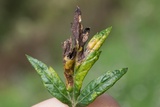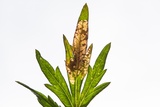Leucospilapteryx omissella (Stainton, 1848) Species
Last modified: Dec. 14, 2024, 11:08 a.m.
A rare species in Belgium. It was discovered in LG in the early 1960s and only at the beginning of the 21st century it spread out all over Flanders and the south, more than likely due to a better knowledge of its biology.
Details
- Classification
- Family: Gracillariidae > Subfamily: Acrocercopinae > Genus: Leucospilapteryx > Species: Leucospilapteryx omissella
- Vernacular names
- Bijvoetblaasmot (NL), Mugwort slender (EN), Beifuß-Miniermotte (DE)
- First mention in Belgium
- Janmoulle E. 1962a. Espèces nouvelles pour la faune belge (suite). — Lambillionea 62(3–6): 39–40, 41. On page 39.
- Status
-
Native
Distribution
Imago
Greyish background, irrorate with dark brown scales; 4 pure white fasciae which are most of the time interrupted in the middle, the middle fascia most conspicuous.
See also gracillariidae.net and bladmineerders.be
Museum specimens
No pictures yet!Specimens in nature
No pictures yet!Caterpillar
The full-grown larva is pinkish red, concolorous with some reddish patches of the leaf mine.
Mine
The mine initially starts as a long gallery that follows a vein or the margin of the leaf and later on it becomes an upper surface blotch. The larva broadens its mine continuously and applies a lot of spinning, turning the initial gallery into a blotch. The blackish frass is usually contained in the center of the mine, between the spinning.
The mine can easily be confused with the one of the Diptera Calycomyza artemisiae (Agromyzidae), but the mine of this fly always stays flat while the one of S. omissella turns into a threedimensional blotch.
See also gracillariidae.net and bladmineerders.be.
Cocoon/pupa
A dull, ochreous cocoon.
Bionomics
Larvae can best be searched for in May–June and again in August–September.
Before pupation the larva leaves the mine. Pupation takes place in a dull ochreous cocoon spun on leaf litter.
The adults are active in late afternoon and later come to light.
Flight periods
The adults fly in two generations a year in May and again in August.
Observed on
- Host plant (species):
- Artemisia vulgaris and Artemisia campestris
The larvae feed usually on the leaves of Artemisia vulgaris, less frequently on A. campestris.


